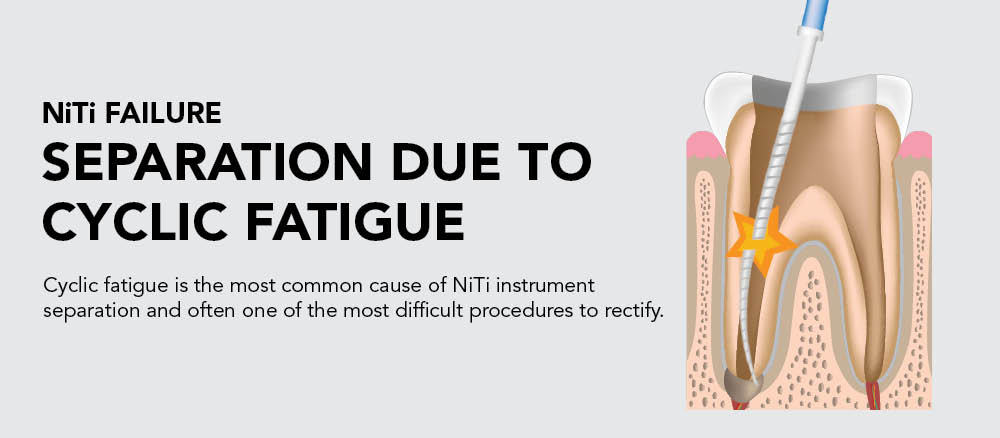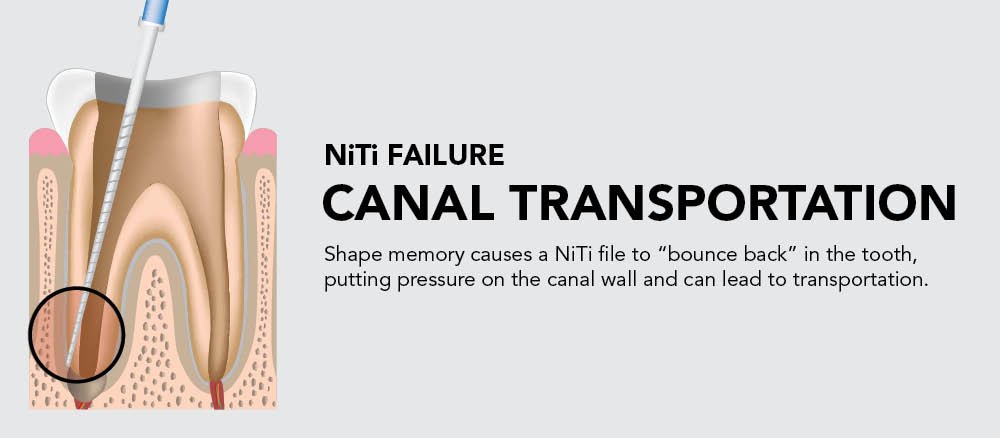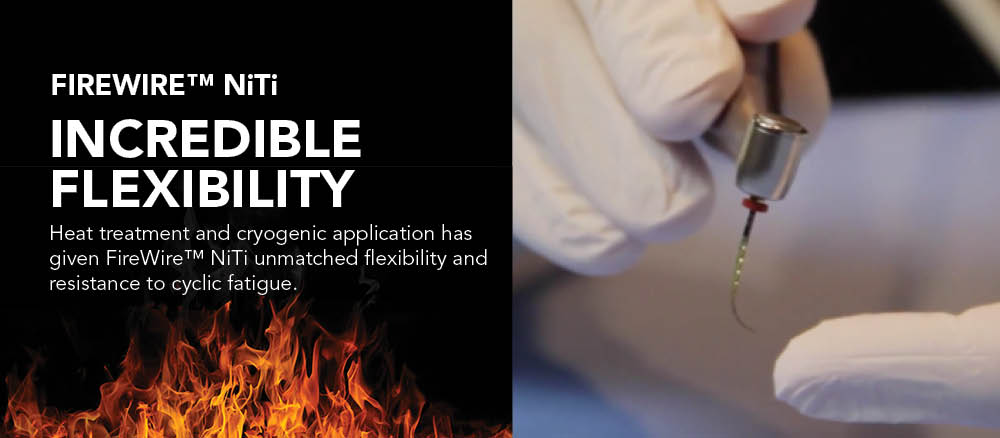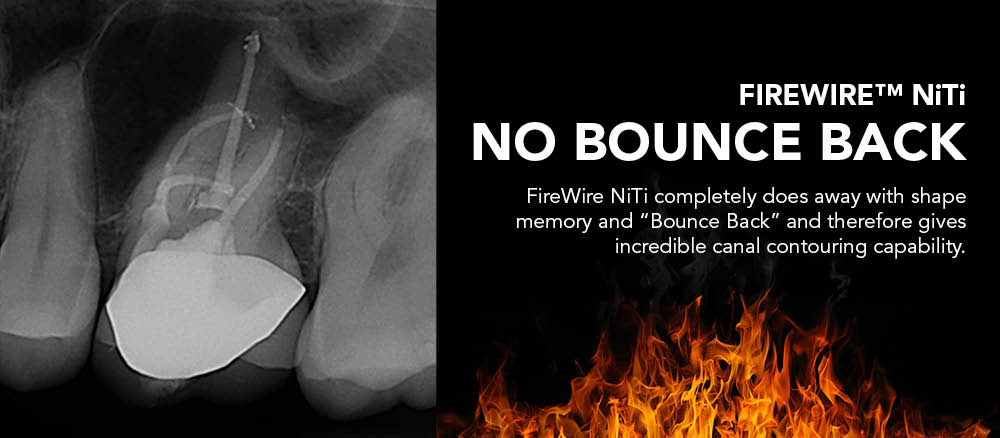More Studies Keep Showing EdgeEndo Domination!
EdgeEndo® files continue to be recognized as superior files. Many manufacturers are focused on refining the performance of NiTi. In recent studies conducted by university students and presented at the AAE conference, EdgeFile® was shown to be significantly more resistant to cyclic fatigue. Cyclic fatigue of a NiTi file occurs when the metal blade is subjected to repeated cycles of tension and compression that lead to stress and hardening of the material. In this study the six rotary files were tested for cyclic fatigue in an artificial canal. The survival of the instruments were tested using Weibull reliability test.
Introduction
Cyclic fatigue occurs due to recurrent tension and compression inside the curved canals that leads to crack formation and propagation that progresses until failure. Many factors affect instrument cyclic fatigue including the type of wire that the instrument is made of, instrument design, instrumentation motion and surface integrity.
The efforts of manufacturers are consistently focused on refining the performance of instruments and increasing their resistance to fracture. Instrument modifications include surface electropolishing, changes in the file design and cross section and the use of reciprocating motions rather than continuous motions.
Recently, Thermal treatment optimizes the microstructure and maximizes the flexibility and resistance to cyclic fatigue of an instrument.
Today, instruments make of controlled memory wires have been introduced to the market and exhibit greater resistance to cyclic fatigue that regular NiTi alloys.
Aim
To compare the cyclic fatigue of six rotary instruments with different nickel-titanium (NiTi) wires.
Method
F2 ProTaper Universal® (PT) and ProTaper Gold® (PTG) (Dentsply, Tulsa Dental Specialties, Tulsa OK, USA), C2 EdgeFile® (EF) (EdgeEndo, Albuquerque NM, USA), R25 RECIPROC® (RC) (VDW, Munich, Germany), Primary WaveOne® (WO) (Dentsply, Taillefer, Ballaigues, Switzerland), and #25 oneShape® (OS) (Micro-Mega, Besancon Cedex, France) (n-15 instruments) were tested for cyclic fatigue in an artificial canal with a 6-mm radium and a 45 degree curvature. The artificial canal within a stainless steel block was milled by using laser with the aid of computer program which reproduced the instrument size and taper and preserved the instruments trajectory that was adapted to the parameters selected. Number of cycles to fatigue (NCF) was recorded; the lateral surface and fractured face of segments were examined using scanning electron microscopy (SEM) and the cross sectional area was measured. one-way ANOVAs and Games-Howell tests were utilized for data analysis.
Results
The EdgeFile had significantly greater resistance to cyclic fatigue, followed by the RC, WO, PTG, OS and PT (p<0.05). The WO and RC were significantly more resistant to cyclic fatigue than the PTG, OS, and PT.
No significant difference was found between the OS and the PTG (p<0.05), and the PT exhibited the lowest resistance to cyclic fatigue compared to the other systems (p<0.05).
Conclusion
The EdgeFile® was significantly more resistant to cyclic fatigue and was followed by the RECIPROC, WaveOne, ProTaper Gold, oneShape and ProTaper rotary files.
The improvements to rotary instruments were proven to increase their resistances to cyclic fatigue.

EdgeEndo® FireWire™ NiTi
EdgeEndo® proprietary heat treatment process called FireWire™ with a combination of heat treatment and cryogenic application has created NiTi unmatched flexibility and resistance to cyclic fatigue. FireWire™ NiTi files provide cyclic fatigue resistance many times greater than other NiTi files. The increased flexibility of Heat treated NiTi allows files to better follow the canal, but EdgeEndo® FireWire™ NiTi does away with shape memory and “Bounce Back” and therefore gives incredible canal contouring capability. Dentin is preserved and canals in apical third are preserved.
The Perfect File for Your Next Root Canal
Effect of Temperature on NiTi Cyclic Fatigue
Dr. Andy Dosanjh – The University of Detroit Mercy
A pilot study conducted at the University of Detroit Mercy showed EdgeFile files to have significantly greater cycles compared to competing files. The purpose of this study was to examine the effect of different temperature changes on the cyclic fatigue of EdgeFile, Vortex Blue, and ESX rotary NiTi instruments. The three groups of NiTi rotary files were tested in a metal block that simulated a canal curvature of 60˚ and 5 mm radius of curvature. The block was submerged in a controlled-temperature water bath filled with water at four different temperatures. Thirty files from each experimental group were tested in the block at each of the four temperature cycles, and rotated at 500 rpm. Time to file fracture was recorded, and converted to number of cycles to fracture (NCF).
Vortex Blue files showed a significant decrease in NitTI cyclic fatigue as temperature increased from 3˚C to 60˚C. ESX files showed a significant decrease in NCF as temperature increased from 3˚C to 37˚C. EdgeFile files showed a significant increase in NitTI cyclic fatigue from 3˚C to 22˚C, and a significant decrease in NCF from 22˚C to 37˚C. For each temperature tested, EdgeFile files showed higher NCF than Vortex Blue files, and Vortex Blue files showed higher NitTI cyclic fatigue than ESX files. The findings showed that temperature does have an effect on the number of cycles to fracture for all rotary NiTi endodontic files tested. The findings from the study suggest that with the exception of files that are already in a martensitic phase, an irrigant chilled below room temperature seems favorable to increase NiTi cyclic fatigue.
In this in vitro study, temperature was found to have a significant effect on the cyclic fatigue of the NiTi rotary files tested. At each tested temperature, NCF of EdgeFile files were higher than NCF of Vortex Blue files, which was higher than NCF of ESX files. At all temperatures, EdgeFile files were found to have significantly higher cyclic fatigue than Vortex Blue files, which had significantly higher cyclic fatigue than ESX files. Since the cyclic fatigue of various file types was found to be significantly affected by temperature, future cyclic fatigue studies are recommended to be conducted at body temperature. Consideration should be taken in interpretation of studies conducted at room temperature.
NiTi is great but needs improvement.
Nickel-titanium [NiTi] rotary files have long been considered superior to stainless steel files for root canal procedures. The shape memory and flexibility of NiTi preserved dentin as well as enabled easier and better access. Since their introduction in 1991, the dental industry has continued innovation and improved the NiTi file with significant developments in metallurgy and design, which have improved shaping properties and flexibility. However, the most commonly used NiTi files still have room for improvement as they often fall short in key areas.
Where “classic” NiTi Fails.
1) Cyclic Fatigue & Separation
Cyclic fatigue of a NiTi file occurs when the metal blade is subjected to repeated cycles of tension and compression that lead to stress and hardening of the material. Eventually this leads to fracture of the metal. Cyclic fatigue is the most common cause of NiTi instrument separation and often one of the most difficult procedures to rectify. Judging when a NiTi file is poised to separate has proven to be very difficult.

2) Canal Transporting
NiTi files exhibit “shape memory” which can initially seem beneficial, as it files do not “wobble” when placed in hand piece. However, shape memory causes a NiTi file to “bounce back” in the tooth, putting pressure on the canal wall and can lead to transportation of the canal, and unnecessary removal of dentin.

Better with Heat Treatment… even better with FireWire NiTi
1. Incredible Flexibility & Resistance to Cyclic Fatigue
Several manufacturers have heat treated NiTi files which increase flexibility and resistance to cyclic fatigue. However, EdgeEndo® proprietary heat treatment process called FireWire™ with a combination of heat treatment and cryogenic application has created NiTi unmatched flexibility and resistance to cyclic fatigue. FireWire™ NiTi files provide cyclic fatigue resistance many more times greater than other NiTi files. See Cyclic Fatigue Test results here.
 Pre-bending the file is a great advantage when approaching a canal with severe curvature.
Pre-bending the file is a great advantage when approaching a canal with severe curvature.
2. No “Bounce Back”
The increased flexibility of Heat treated NiTi allows files to better follow the canal, but EdgeEndo® FireWire™ NiTi does away with shape memory and “Bounce Back” and therefore gives incredible canal contouring capability. Dentin is preserved and canals in apical third are preserved.

Case by Dr. Yanina Figueroa featured on RootCanalRockStar.com
EdgeEndo files with FireWire™ NiTi
EdgeEndo® offers a full line of FireWire™ NiTi Heat Treated Rotary Files. EdgeFile®, EdgeTaper Platinum™, EdgeSequel Sapphire™ and EdgeEvolve™, are each designed to be compatible with popular file systems with blade cross sections to cater to a doctor’s preference. All are treated with the FireWire™ process giving them incomparable ability to carefully follow the canal, preserving canal anatomy & dentin and allowing faster procedures making for increased productivity and ultimately happier patients.
'전동파일' 카테고리의 다른 글
| 에지파일 X1, 웨이브원, 레스프록 호환 (0) | 2017.04.06 |
|---|---|
| 에지엔도 : 글라이드패쓰파일(프로글라이더호환), 엑스원파일(웨이브원호환), 에지테이퍼(프로테이퍼 호환) (0) | 2017.03.30 |
| edge endo 전동파일: 프로테이퍼, 웨이브원, 레시프록 호환 (0) | 2017.01.21 |
| 오스코 근관치료 관련 제품: 오쏘엠티에이, 리트로엠티에이, 전동파일, 초음파팁, 전동파일,엔도니들팁 기타 (0) | 2016.06.07 |
| 전동파일 부러짐의 주 원인은 반복사용으로 인한 금속피로 누적! (0) | 2016.05.25 |









